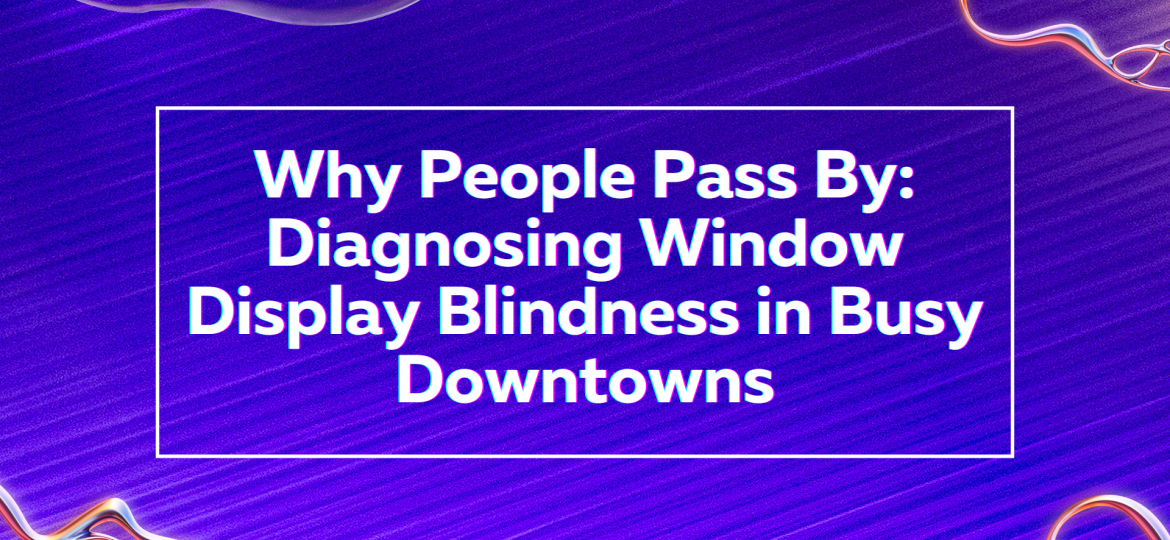Why People Pass By: Diagnosing Window Display Blindness in Busy Downtowns
In busy downtown areas, stores rely heavily on foot traffic. But here’s the catch—if people walk by without noticing your storefront, you’re invisible. This is called window display blindness, and it’s more common than most businesses realize.
The problem isn’t always poor design. Sometimes it’s the fast-paced environment, overstimulated customers, or too many competing visuals. Diagnosing window display blindness is the first step to fixing it. Below are practical, proven steps to help you spot if your storefront is being ignored and how to improve it.
Easy Steps to Diagnose Window Display Blindness in Busy Downtowns
Step 1: Watch How People React
The best way to tell if people notice your display is to watch them in real time.
- Spend 30 to 60 minutes observing your storefront from a distance.
- Count how many passersby look at the display, slow down, or stop.
- Use existing CCTV footage if you have it to review engagement patterns.
If most people walk by without a single glance, your display isn’t doing its job.
Step 2: Test the Visual Impact
Your display might look good to you, but in a downtown setting, it needs to do more than look good—it has to grab attention instantly.
Do this:
- Step across the street and view your display like a pedestrian.
- Take a photo and compare it to nearby storefronts.
- Ask: Does your window stand out? Is there a clear focal point? Is it too cluttered or too plain?
If your display visually blends in with the surroundings, it’s likely getting ignored.
Step 3: Do a 3-Second Walk Test
People walking through downtown don’t stop to analyze. They move fast, and your display has 3 seconds or less to catch their eye.
Ask yourself:
- Can I tell what the store is about?
- Did anything catch my eye?
- Would I stop to look?
If the answer is no, the display isn’t effective.
Step 4: Gather Direct Feedback
Sometimes, the best insights come from others. Ask honest questions to your customers, employees, and even strangers:
- “When you walk past our store, what stands out?”
- “Would you notice the display if you didn’t already know the brand?”
- “Is there anything that would make you stop and look?”
This type of feedback reveals blind spots you might not catch yourself.
Step 5: Review Your Display at Different Times
A display that looks fine at 2 p.m. may be invisible at 8 p.m. You need to assess visibility throughout the day.
Things to check:
- Lighting: Is it too dim or too harsh?
- Glare and reflections: Especially on glass, these can hide your display entirely.
- Digital screens: Are they too bright during the day or too dim at night?
If your window display disappears at certain times, you’re missing opportunities.
Step 6: Rotate Display Elements Regularly
Many downtown passersby take the same route every day. If your display stays the same for weeks, people stop noticing it, even if it’s well-designed.
Keep attention fresh by:
- Updating key items or themes every 10–14 days.
- Changing colors, arrangements, or featured products.
- Adding seasonal or event-based visuals.
Even small changes can bring eyes back to your window.
How to Make Your Display Impossible to Ignore
Movement draws attention. In downtown areas filled with static visuals, 3D holographic displays create a new level of visibility. These eye-catching visuals float in mid-air, change dynamically, and pull attention instantly, even from distracted pedestrians.
Stores using holographic window advertising see higher engagement simply because people can’t help but stop and look.
Conclusion
Window display blindness is a common issue for businesses in busy downtown areas. When people stop noticing your storefront, you lose out on potential customers. The good news is, it’s fixable. By observing real behavior, testing visibility at different times, rotating visuals, and asking for honest feedback, you can identify what’s not working and start capturing attention again.
Creativ Buzz helps modern retailers go beyond static displays by offering 3D holographic advertising in high-traffic venues. It is a smarter way to get noticed and turn passing traffic into real engagement.




